|
I want to publically apologize for some of my
media colleagues who have been recommending natural-sounding
remedies which do NOTHING to solve target problems which are
seasonal and feasiblely uncontrollable. The only changes these
so-called "remedies" make is a decrease in the gullible
persons bank account. These atrocities became paramount to me
as I listened to a garden "expert" recommend garlic
extract and soil activators for multiple soil drenches to cure
the cause of dead leaves on Arizona Ash trees and eliminate
worms hanging from webs on the same trees. The Arizona Ash trees
had dead leaves because of the fungus disease Anthracnose which
occurs several times in the early spring and eventually is eliminated
by hotter, drier weather. The worms come every year, complete
their life cycle and disappear---as outlined and identified
at: http://www.plantanswers.com/garden_column/april04/1.htm
By the time the curative recommendations of garlic extract and
soil activators were being made, the problems had cured themselves
and only the leaf damage and the memories of the worm problem
remained. Money spent on these "remedies" was completely
wasted unless there were some therapeutic ramifications for
the caller -- who was actually the victim of this useless, costly
advice.
With that sorry episode fresh in our memories,
I want to warn you of some other problems which you will need
to avoid getting useless remedies for and wasting your families
valuable resources on. If you have an abundance of financial
resources which you wish to dispose of in a reckless fashion,
I know a young man named Jeremy Parsons who would accept as
much financial aid as you want to squander. Hopefully, we have
the potential of getting better returns on our money invested
in that project than from the use of garlic extract and soil
activators! Some horticulture pitfalls to avoid:
RED TIPPED PHOTINIA PROBLEMS
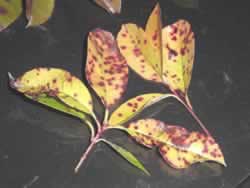
Foliage disease combined with iron chlorsis problems make
Red Tipped Photinias a poor shrub choice -- hollies are
the answer |
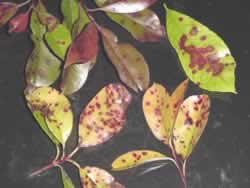
Red Tipped Photinias as so susceptible to iron chlorsis
in some areas that the red on the leaf spots are the only
red the plant displays! |
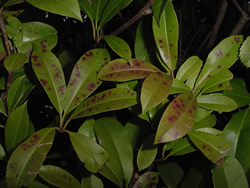
It is not practical or feasible to try to prevent this
foliage disease of Red Tipped Photinia |
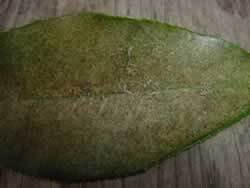
Spider Mite on Red Tip Photinia Leaf 2 |
This is the most commonly sold shrub and, by far,
the most problem-prone shrub in Texas. This shrub is highly
susceptible to Red Tip Leaf Spot and yellowing caused by iron
chlorsis. There is no practical cure for either problem. There
is an impractical treatment which is a product (Fertilome Liquid
Systemic Fungicide) which contains Propiconazole (Alamo - Banner)
of oak wilt fame. It is labeled for Red Tip Leaf Spot. Propaconazole-Banner
Maxx-has been shown to be pretty good for Entomosporium leaf
spot control in red tip. And here is all you have to do. Start
application early and preventatively, especially while young
leaves are developing and sizing up. Reapply as frequently as
label will allow, probably 10-14 days, until leaves are fully
mature...then re-apply as needed to protect new flushes as they
occur. Plants with chronic or historical problems with leaf
spot should be aggressively treated as mentioned above....plants
that have not had a problem, probably scout and apply at first
sign of infection, or maybe 1-2 preventative applications....also,
important is to collect and destroy all infected leaf litter
from below plants. Also, get a good line-of-credit from the
bank before starting this treatment since every year as the
plant gets larger, the treatments will be more costly. The PRACTICAL
treatment is to eliminate sickly red-tipped Photinias as soon
as possible and replace them with hollies. If you do not have
red-tipped Photinias planted in the landscape-DON'T!!!
SPIDERMITES
The most prolific, elusive insects (which are
really spiders) of any garden are the spider mites. These girls
coined the phrase strength in numbers and they are committed
to the cause! When conditions are optimum (hot and dry), they
can double their population in 4 days. Don't feel sorry for
the requirements placed on the male in order to accomplish this
feat - - their services are not required, but once. Isn't that
sick?! These gals have taken woman's liberation too far; they
only visit their male counterpart once during a lifetime. What's
worse is that some ladies eat the male after the encounter -
- that's gratitude for you!
Even though mites are small, their huge populations
are mighty when potential plant damage is considered. These
mighty small spider mites are often unnoticed by gardeners until
the plant has been severely damaged. Spider mites flourish in
hot, dry conditions. They are named for the webs they make on
their host plants while feeding. Spider mites usually feed on
the undersides of leaves and cause a stippled bronze coloration
dotted with yellow specks, and webbing is usually present on
the underside of leaves.
Gardeners respond by using carbaryl (Sevin).
This often eliminates beneficial insects which consume spider
mites and allow their populations to multiply rapidly. The mite
is not an insect but rather related to spiders. They can only
be controlled with a spider-killing miticide such as Kelthane
or products containing kelthane. Add one teaspoon of a liquid
soap per gallon of pesticide spray to insure good wetting of
foliage and try to spray the bottoms of leaves as much as possible.
When mites are detected, apply miticide spray every four days
for four consecutive sprays. Since mite eggs hatch ever 3-5
days and since miticide sprays kill only the adults, consecutive
sprays will hopefully destroy the young before they reach puberty.
Organic gardeners can use sulfur to control mites,
but do not apply on squash or other vine crops. Other treatments
range from permethrin sprays to insecticidal soaps to neem oil
or orange oil products. Strong streams of water and liquid seaweed
have also shown some effects on these tiny sapsuckers.
NOTHING works when populations are dense and
weather is hot and dry. The best control is destruction of infested
plant materials.
WEBWORMS
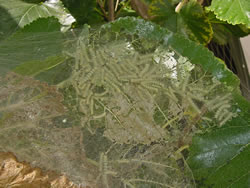
Webworms are back and there is NOTHING anyone can do about
them---except let Nature take its course! |
When the webworms begin, just stay in the house
and wait for the populations to decline-which they will from
year to year. Webworms have been written about and complained
about for years with no apparent affect on the population. On
March 21, 2004, it was announced http://bexar-tx.tamu.edu/HomeHort/F1Column/2004Articles/MAR21.htm
that "The City of San Antonio, Texas Forest Service, Texas
Cooperative Extension, Bartlett Tree Care and City Public Service
have joined together to examine the effectiveness of releasing
Trichogramma wasps into pecan trees as a way to slow down the
rampant explosions of webworms seen in San Antonio over the
past 2 to 3 years. Four city park areas will be targeted for
this study with releases being conducted in mid to late April
and again in mid to late June." That event yielded such
inconclusive results (meaning that no one in their right mind
could see any discernable differences in populations of webworms
in the treated area!!!) that it was recommended again on May
30, 2004
http://bexar-tx.tamu.edu/HomeHort/F1Column/2004Articles/MAY30.htm
and yet again on June 20, 2004
http://bexar-tx.tamu.edu/HomeHort/F1Column/2004Articles/JUNE20.htm
Please do not waste your money on such a folly. Why is it a
folly? No one denies that these wasps feed on webworm eggs but
huge numbers of the wasps would have to be simultaneously evenly
distributed over a massive area to see any significant population
reduction. The release would have to be timed perfectly. A few
folks doing releases in their own backyards amounts to a drop
in the ocean or sort of like spitting on a forest fire! Left
alone, these insects, as do all insect populations, will cycle
and decrease in numbers after a population explosion has occurred.
I have seen this happen with the diamond-back moth on cabbage,
leafminers on peppers and thrips spreading tomato spotted wilt
virus. Pecan trees have been surviving population surges of
webworms for hundreds of years so they will survive our most
recent problems. If only our population can endure the ugliness
caused by tree defoliation and webbing.
I hope you will think about the "uncontrollables"
in your landscape and not fall prey to the idea that you can
man-handle Nature. For goodness sake, if you want to attack
some of these insurmountable problems, don't waste your money
on foolish man-made remedies. Saw the red-tip Photinias down,
bury the spidermites, and burn the webworms out of the trees.
|



